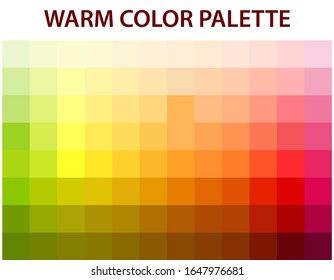

The key principles of balance when learning how to mix colours is between warm and cool colours.

(You can find all five from Color Louvers.The more you look for warm and cool colours in paintings the more you will see them. Here are five warm color palettes to get you started. Nature, photos, a mood – all can be great sources of color inspiration. Just like with any other color palette, look to things around you as a source of inspiration. Now that you are ready to roll with a project that uses a warm color scheme, how do you pick a palette? How bright should it be? Where will the inspiration come from? In printed projects, using four-process CMYK color, warm colors will have the highest magenta and yellow values and low cyan or black percentages. In digital projects, using RGB color, warm colors will have the highest red values and lowest blue values. When it comes to practical application and color mixing, you can determine warmth or coolness of color by its makeup. To maintain the warmth of the palette, use 80 percent reds, oranges, yellows and pinks in color locations and 20 percent blues, greens and violets. Use that same idea with a combination of warm and cool colors. When working with color, 80 percent of the canvas is neutral (think about things like the background or color of the main body text) and 20 percent of the design uses bold or strong color. Following the basic concept of the color wheel, start with a warm color and partner it accordingly for the best results. The best option for working with warm and cool color simultaneously is to select colors with complementary tints or saturations. Some of the best designs with a focus on warm-only color are simple, direct and even monochromatic. Remember to create contrast – super-bright warm colors need a static backdrop as a settling property, otherwise these colors can appear too active, busy or over-stimulate. The opposite will also work, using a dark scheme and black. The result is a crisp, clean and bright feel to color. When working with warm colors, I like to use simple neutrals or white. They key is mixing colors to fit your message and pairing them with other offsetting hues. Red, for example, can be overpowering or pink can feel too feminine. While warm colors are popular design choices they can sometimes be difficult to use. Just make sure you understand how the contrasting hues may work together (or against each other) and how that color choice pertains to your overall message. While some argue as to whether you should mix warm and cool colors in a single palette, it is a perfectly acceptable use of color. Use warm colors in projects where the goal is to convey a sense of happiness, enthusiasm or energy.
:max_bytes(150000):strip_icc()/understanding-warm-and-cool-colors-1976480_Final-5bcf5cf7c9e77c005113f05e.png)
It refers precisely to where the color falls on the color wheel. The “warmth” of a color has nothing to do with its brightness or color saturation or tint. And unlike other color definitions, has nothing to do with their reflective properties or light absorption. The terminology – warm and cool – is emotional and psychological. Charles Hayter’s colour circle of 1813 appears to mark their earliest appearance in a published colour system, but the terms can be traced back in artist’s correspondence as far as 1727,” Briggs wrote. “They seem not to have been applied to colours until soon after artists first saw their range of hues laid out in a circle.

Color theorists believe that the evolution of warm and cool colors came is linked to the color wheel, according to “ The Dimensions of Colour” by David Briggs. The actual division on the color wheel can vary slightly but is most often conveyed as from yellow to red-purple. Reds, oranges, yellows and pinks are warm colors. Warm colors occupy one half of the color wheel and are the hues that are reminiscent of the sun or fire.


 0 kommentar(er)
0 kommentar(er)
